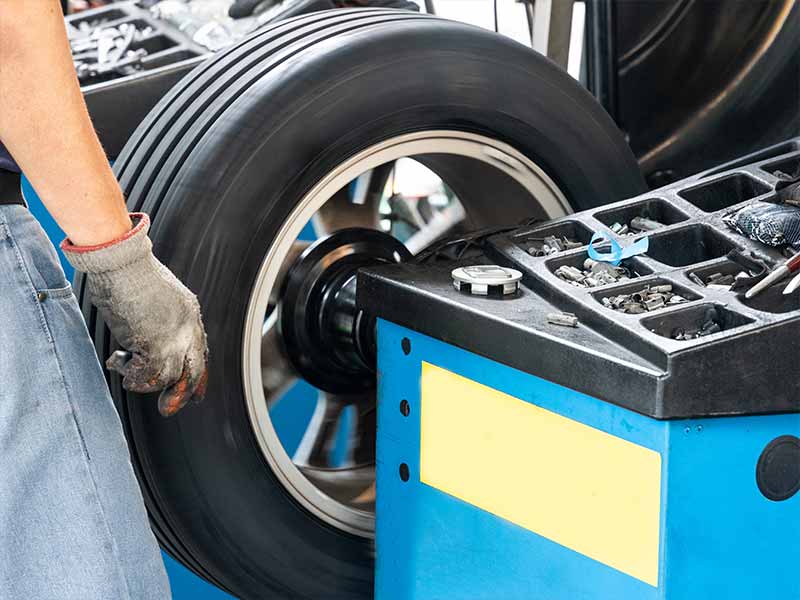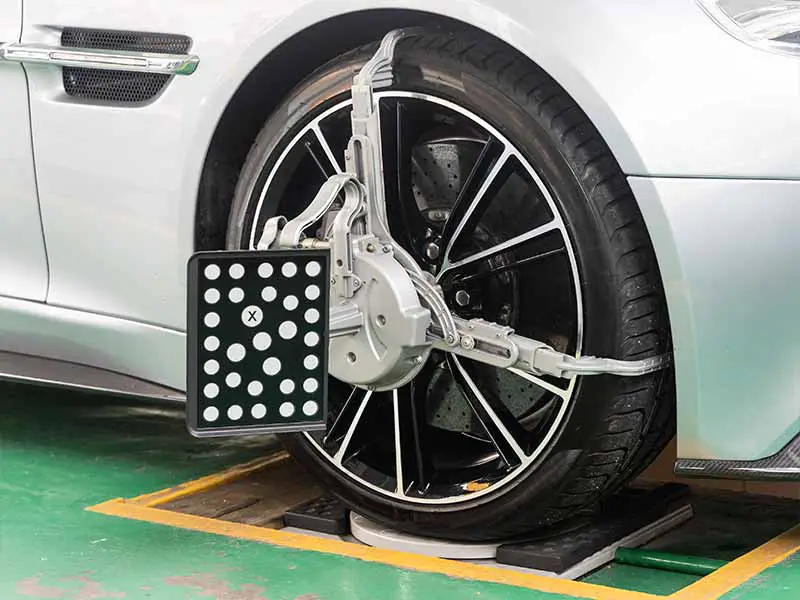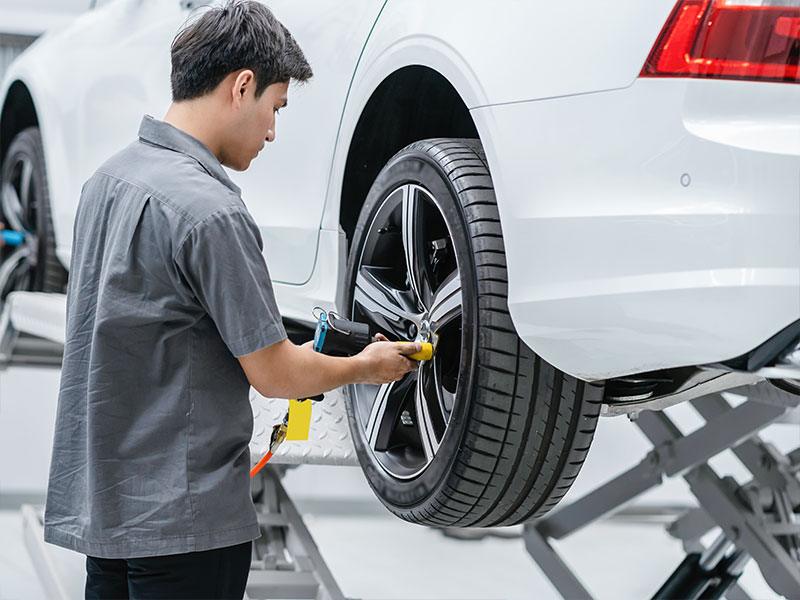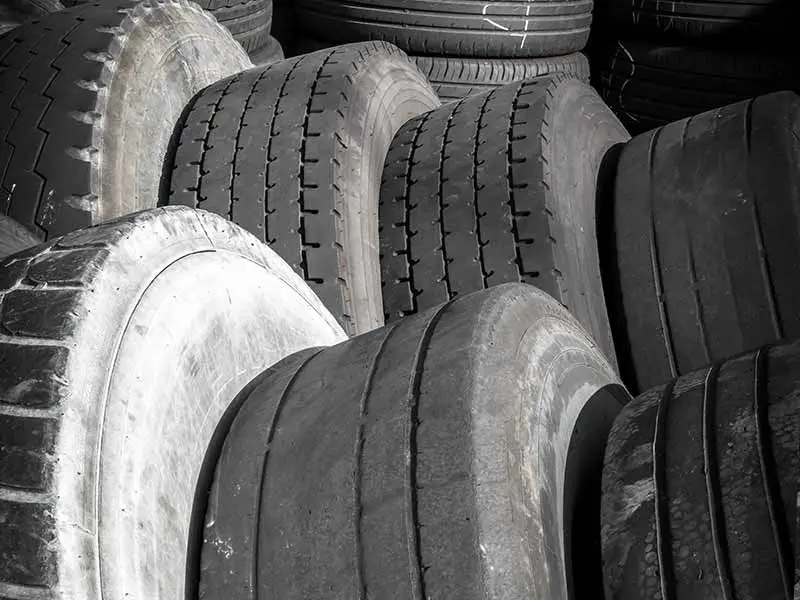Uneven tire tread wear patterns that are inconsistent around your tires are know as patch wear. The cause of this type of wear pattern is often more difficult to diagnose because it is often caused by more than one problem.
Because of this, we need to take a step back and understand all of the common causes of uneven tire wear patterns and their fixes.
Patch Wear
Patchy Wear is an uneven tire wear pattern that is inconsistent across the width and circumference of the tire.
This wear can be caused by a combination of the common problems that cause poor tire wear patterns. It can also be the result of broken belts within your tire.
Even though the cause of inconsistent wear around the circumference of your tire may be difficult to diagnose, there are some basic tire maintenance services that should be done regularly that will likely solve the problem for you.
These maintenance practices will also help prevent all poor tire wear patterns in the future.
Let’s take a closer look.
What Causes Patchy Tire Wear?
Random, patchy, uneven tire wear patterns can be a little more confusing to troubleshoot since they may be the result of more than one problem.
Most uneven tire wear patterns are consistent around the circumference of the tire. When the wear pattern is patchy, the problem can be simply a balance issue or bent wheel that appears like patchy wear but may actually be more consistent upon closer inspection.
Broken Belts Within Your Tire
One potential source on unusual wear on the inner or outer edge of your tire tread is internal damage or manufacturing defect.
Steel belts are embedded within the structure of the tire and help it hold the proper shape. If these steel belts snap from potholes, curbs, or manufacturing defects, the tire can become out of round and wear in unusual ways.
Let’s cover some of the common causes of uneven tire wear that can be involved in creating a patchy wear pattern around your tire.
Proper Tire Pressure
It’s important to check your tire pressure regularly. Many drivers will rely on their tire pressure monitoring system (TPMS) to alert them to a problem and never bother checking their tire pressure themselves.
The concern with relying on your TPMS to let you know when to add air to your tires is that it is too late to prevent uneven tire wear. Your TPMS is designed to warn you when the air pressure is 25% too low. It’s a failsafe to warn you of a potential catastrophic blowout is highly likely if you don’t address the problem soon.
Under inflated tires will wear your tires on both shoulders while putting less pressure on the center of the contact patch. Overinflated tires will have center wear with much less wear on the two shoulders.
The correct tire pressure is listed on the tire information sticker in you driver’s door jamb or in your owner’s manual. Occasionally you can also find the air pressure info in the glove box or inside of the gas filler door.
Checking your tire pressure regularly is important to getting the most life out of your tires and ensuring that they grip the road as best as possible.

Out Of Balance Tire
A tire that is not properly balanced can sometimes be confused as patchy or random wear when it is actually more consistent around the entire tire when more closely examined.
All tire and wheel assemblies require balancing when originally installed, but they also occasionally need rebalancing as the tires wear down over time and can lose balance.
Also, wheel weights that are used for balancing tires can come off of your wheels for many reasons without you realizing this has happened.
We recommend rebalancing your tires every 10,000 miles to ensure that you get the most out of them. Balancing is an inexpensive service that can save you money in the long run.

Bent Wheel
Wheels are built to be extremely tough but they have their limits. Bent rims or wheels are usually caused due to hitting potholes at high speeds, curb strikes, or even harsh speed bumps.
If a wheel becomes slightly out of round either laterally or vertically (also known as runout) the tire can wear unevenly similar to a tire that is out of balance.
Replacing wheels can be very expensive. Both OEM and aftermarket wheels are not cheap. Steel wheels with hubcaps are much less expensive and much less expensive to replace.
Repairing your wheels is often possible of the damage isn’t too extreme. Contact your local tire shop to see if they offer wheel repair services or can direct you to a wheel repair shop in your local area.
Out Of Alignment
Alignment issues are a common source of poor tire wear patterns. Camber, caster, and toe alignment need to all be within the proper specifications to ensure that your vehicle drives straight and true.
What many vehicle owners don’t realize is that your tires don’t actually sit straight and flush with the pavement. Each tire is adjusted and slight angles to improve stability and traction.
These adjustments will cause your tires to wear unevenly themselves, but when they are out of proper alignment, the inconsistent wear can happen much more quickly. And an improper alignment can reduce handling performance and safety.
Performing an alignment check every 10,000 miles is important to ensuring that your tires wear evenly and your vehicle is able to perform its best when you need it to do so.

Worn Suspension Components
Over time, ball joints, bushings, shock absorbers, and other suspension system parts wear out. When they do, they lose their ability to properly keep your tires in contact with the road surface and pointed in the right direction.
Most suspension system components will last for many tens of thousands of miles before wearing out to a point that they need to be serviced or replaced. If your car or truck is beginning to show its age and your tires are not wearing evenly, you should have your suspension parts inspected for failures.
Some components in your suspension can fail and not be too critical, while when others fail it can be extremely dangerous.
Uneven tire wear may be the early warning sign you need to discover the potential ticking time bomb of a looming suspension component failure.
Regular Tire Rotation
Tire rotation won’t fix or necessarily prevent patchy wear on your tires, but it will help reduce the negative effects and extend the overall life of your car or truck tires. It’s a tire maintenance task that often gets dismissed or overlooked.
Regularly rotating your tires is an important tire maintenance service to have performed every 5,000 miles for a few reasons.
No tire sits straight and flush with the road. Each tire around your vehicle is aligned at slight angles to improve handling and traction. This means that even properly aligned tires will have an uneven wear pattern.
Other than alignment, there are many additional variables that can cause unusual wear patterns. Tire rotation will also help reduce the negative effects of these tire wear issues. It will also get eyes on your tires regularly to help identify problems early, before they become serious problems.
Last, most tire manufacturers provide a tire warranty that will provide a refund on any mileage that hasn’t been realized from the warranty guarantee. These warranties usually require your tires be regularly rotated every 5,000 miles for a claim to be honored.

Resources
Below are some links you may find helpful when learning about tires
- How to read tire wear patterns – Firestone
- Tire wear patterns can be a sign of bigger issues – Metromile
Final Thoughts
No matter the cause of your patchy tire tread wear, understanding proper tire maintenance tasks and tire wear patterns is helpful knowledge.
We suggest reading more about common tire wear patterns such as toe wear, center wear, cupping wear, and other tire tread wear problems.
Hopefully you have a good grasp on what the source of your problem is and you’ll be performing regular wheel alignment, tire rotation, and tire pressure checks in the future to catch these uneven wear problems early.
Good luck and happy motoring.





